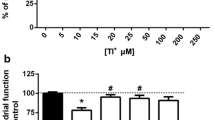Abstract
The chronic administration of disulfiram (DS) to rats resulted in significant decrease of synaptosomal Ca2+, Mg2+-ATPase activity. In vitro studies indicated that DS (ID50=20 μM) produced a dose-dependent inhibition of Ca2+, Mg2+-ATPase. However, diethyldithio-carbamate, a metabolite of DS, failed to modify Ca2+, Mg2+-ATPase activity, implying that the decrease in ATPase activity in DS administered rats was due to the effect of parent compound. The DS-mediated inhibition (48%) of ATPase activity was comparable with a similar degree of inhibition (49%) achieved by treating the synaptosomal membranes with N-ethylmaleimide (ID50=20 μM) in vitro. Furthermore, the inhibition by DS was neither altered by washing the membranes with EGTA nor reversed by treatment with sulfhydryl reagents such as GSH or dithiothreitol. About 74% and 68% decrease of synaptosomal Ca2+, Mg2+-ATPase specific activity was observed when treated with DS (30 μM) and EGTA (100 μM) respectively. The remaining 25–30% of total activity is suggested to be of Mg2+-dependent ATPase activity. This indicates that both these drugs may act on a common target, calmodulin component that represents 70–75% of total Ca2+, Mg2+-ATPase activity. Therefore, DS-mediated modulation of synaptosomal Ca2+, Mg2+-ATPase activity could affect its function of maintaining intracellular Ca2+ concentration. This could contribute to the deleterious effects on CNS.
Similar content being viewed by others
References
Nagendra, S. N., Shetty, K. T., Subhash, M. N., Udaya, H. B., and Pradhan, N. 1993. Effect of disulfiram administration on tryptophan, serotonin and peripheral tryptophan content. Neurochem. Int. 22:31–36.
Molinengo, L., Oggero, L., Ghi, P., and Orsetti, M. 1991. Action of a chronic disulfiram administration on memory decay and on central cholinergic and adrenergic systems. Brain Res 551:72–77.
Nilsson, G. E., Tottmar, O., and Wahlstrom, G. 1987. Effects of aldehyde dehydrogenase inhibitors on hexobarbital sensitivity and neuroamine metabolism in rat brain. Brain Res 409:265–274.
Goldstein, M., and Nakajima, K. 1967. The effect of disulfiram on catecholamine levels in the brain. J Pharmac Exp Ther 157:96–102.
Nilsson, G. E., and Tottmar, O. 1989. Effects of disulfiram and coprine on rat brain tryptophan hydroxylation in vivo. Neurochem Res 14:537–540.
Major, L. F., Murphy, D. L., Gershon E. S. and Brown G. L. 1977. The role of plasma amine oxidase, platelet monoamine oxidase, and red cell catechol O methyl transferase in severe behavioral reactions to disulfiram. Am J Psychiat 136:679–684.
Simonian, J., Haldar, D., Delmaestro, E. and Trombetta L. D. 1992. Effect of disulfiram (DS) on mitochondria from rat hippocampus: Metabolic compartmentation of DS neurotoxicity. Neurochem Res 17:1029–1035.
Kelner, M. J., and Alexander, N. M. 1986. Inhibition of erythrocyte superoxide dismutase by diethyldithiocarbamate also results in oxyhemoglobin-catalyzed glutathione depletion and methemoglobin production. J. Biol. Chem. 261:1636–1641.
Vallari, R. C. and Pietruzsko R. 1982. Human aldehyde dehydrogenase: Mechanism of inhibition of disulfiram. Science 216:637–639.
Nagendra, S. N., Madan, A. and Faiman M. D. 1994. S-methyl N,N-diethylthiolcarbamate sulfone, an in vitro and in vivo inhibitor of rat liver mitochondrial low Km aldehyde dehydrogenase. Biochem. Pharmacol 47:1465–1467.
Nagendra, S. N., Shetty, K. T., Mamatha Rao K., and Sridhara Rama Rao B. S. 1993. Effect of disulfiram administration on rat brain glutathione metabolism. Alcohol 11:7–10.
Sobue, K., Ichida, S., Yoshida, H., Yamazaki, R., and Kakiuchi S. 1979. Occurrence of a Ca2+ and modulator protein-activable ATPase in the synaptic plasma membrane of brain. FEBS Lett 99:199–202.
Javors, M. A., Bowden C. L., and Ross D. H. 1981. Kinetic characterization of Ca++ transport in synaptic membranes. J Neurochem 37:381–387.
Sorensen, R. G., and Mahler H. R. 1981. Calcium-stimulated adenosine triphosphatase in synaptic membranes. J Neurochem 37:1407–1418.
Gandhi, C. R., and Ross, D. H. 1988. Characterization of a high affinity Mg++-independent Ca++-ATPase from rat brain synaptosomal membranes. J. Neurochem. 50:248–256.
Mamatha, R. K., and Nagendra S. N. 1994. Effect of disulfiram adminstration on glutamate uptake by synaptosomes in the rat brain. Eur. J. Pharmacol (In press).
Dunkley, P. R., Jarvie P. E., Heath J. W., Kidd G. J., and Rostas J. A. P. 1986. A rapid method for isolation of synaptosomes on percoll gradients. Brain Res 372:115–129.
Sapru, M. K., Geetha, H., and Shetty K. T. 1987. A single reagent method for phosphate estimation in phosphatase(s) assay. Ind J Biochem Biophys 24:340–343.
Lowry, O. H., Rosebrough N. J., Farr A. L., and Randall R. J. 1951. Protein measurement with the Folin phenol reagent. J Biol Chem 193:265–275.
Laplane, D., Attal N., Sauron B., De-Billy A., and Dubois B. 1992. Lesions of basal ganglia due to disulfiram neurotoxicity. J Neurol Neurosurg Psychiatr 55:925–929.
Cobby, J., Mayersohn M., and Selliah S. 1977. The rapid reduction of disulfiram in blood and plasma. J Pharmacol Exp Ther 202:724–731.
Nagendra, S. N., Shetty K. T., Subhash M. N., and Guru S. C. 1991. Role of glutathione reductase system in conversion of disulfiram to diethyldithiocarbamate. Life Sci 49:23–28.
Agarwal, R. P., Phillips, M., McPherson, P. A., and Hensley P. 1986. Serum albumin and the metabolites of disulfiram. Biochem. Pharmacol. 35:3341–3347.
Brien, J. F., and Loomis C. W. 1985. Aldehyde dehydrogenase inhibitors as alcohol-sensitizing drugs: a perspective. Trends Pharmac Sci 6:477–480.
Author information
Authors and Affiliations
Rights and permissions
About this article
Cite this article
Nagendra, S.N., Mamatha Rao, K., Subhash, M.N. et al. Disulfiram lowers Ca2+, Mg2+-ATPase activity of rat brain synaptosomes. Neurochem Res 19, 1509–1513 (1994). https://doi.org/10.1007/BF00968998
Accepted:
Issue Date:
DOI: https://doi.org/10.1007/BF00968998




